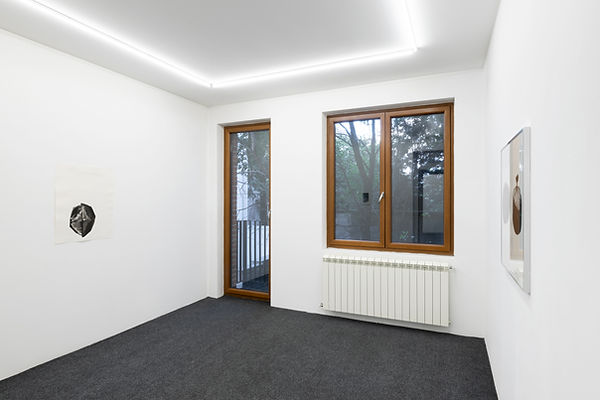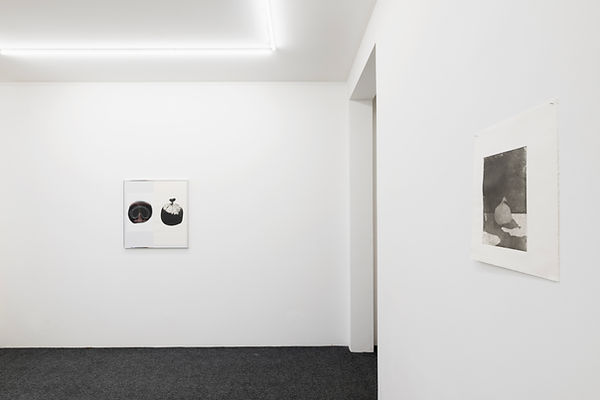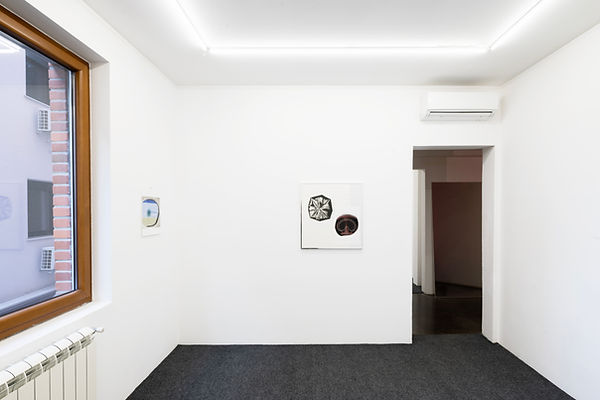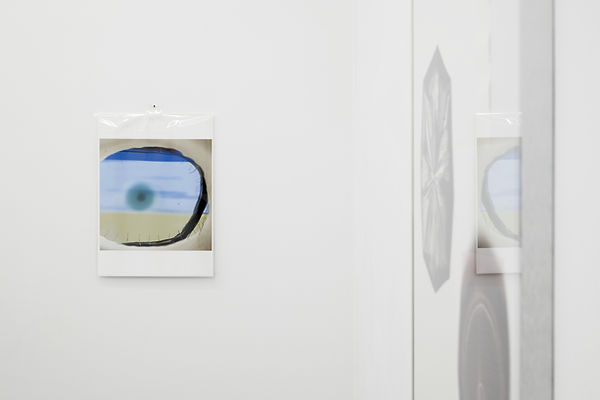Show 4
Friendship
Francesco Cagnin
Bernhard Hegglin
20 July - 6 September 2025
Tikveška 1
11010 Belgrade
I spent my final three days with Keith in Edinburgh, after living in Glasgow for nearly fifteen years. Over the next 72 hours, we engaged in much of the same activities we have done for the past decade of our friendship. We drank what we believed was an adult and measured amount of wine, but was truly repulsive in hindsight. We rolled and smoked cigarettes, and niftily, Keith taught me to wrap my fingers with scotchtape when smoking in private, as ’niccy stains’ are decidedly un-chic. On the last day, we ate oysters and afterwards Keith coerced me, for his own amusement, to go on a trampoline bungee harness for children. I spent the remainder of that day violently throwing up in his bathroom. Early the next morning, I took a taxi, cried listening to “You and Me” by the Cranberries on repeat and moved away.
I’m not entirely sure I have carte blanche here to write whatever or what form this text should take, but I’ll attempt something anyhow, and write a soupy, sentimental love letter to friendship. Disclaimer: Sometimes friendships aren’t really friendships, just transactions you didn’t realise in the moment. In its best form, friendship begins with not much. Not a motive, not a “what can you do for me” angle. It’s sort of an empty space, soon to be occupied with discussions, schemes, healthy doses of stupidity, and often mistakes. I write about Keith, because write about what you know, right? He endeared to me one night, the first shift we worked together, saying I looked like one of the Haim sisters. When he clarified it was the ‘hot’ one and appealed to my ego, I pulled up a chair and let him sit next to me for after-work pints. I look nothing like Danielle Haim, and Keith is not visually-impaired, go do the math.
As relationships are likely to do, so comes a point when friendships graduate past the convenience stage. Common interests can become less common, inconsequential at times. By now, you share in each other’s achievements, absorbing disappointments and enduring failures, regardless of how far all this may be from your own individual interests. If the best of friendships are not transactional, they are however conditional - conditional on reciprocity. Though he has nothing to gain from my relentless search for apartments, jobs or whatever the wish of the day is, Keith dutifully logs in my prayer requests with his Irish mother who seems to be at one with the holy spirit (lately, the prayers haven’t been coming through but I’ll chalk it up to the change in Pope and this transition period at the Catholic Church). That is not to say, in direct accordance to reciprocity, that I will pray back for him or ask my own mother to do so. But I will give my attention to his needs when the time calls for it, listen (even when I don’t understand), and dispense painful truths (even when I am terrified to).
I deliberately did not want to delve into the work in this show - and at the time of writing, I also do not know what Beni and Francesco have chosen to exhibit - but rather to commend them on the subject choice. The show announcement is a phone image of the two artists’ shadows on a sidewalk, mid-stroll, one probably chosen from many across their joint camera rolls. I am not privy to the hours, days, years of conversations between the two, though I cannot help but deduce the hand their personal relationship has played in trusting each other with this show, allowing one another into their respective processes.
*
I was reminded the other day that in some of the languages spoken around this region, ‘friend’ can be used as a verb, as in ‘druženje’. It’s given me much thought to it is as an action, particularly as this exhibition is held in Belgrade, in Serbia — a place heavily reliant on friendships and empathy for the day to day function, rather than on institutional support structures. While it is no intention of mine to politicise or insert such a narrative where there is none, friendship as a subject could not be more timely - sometimes the reading can’t help but reflect the context.
Anecdotal as much of this is, memories are sometimes best laid evidence to friendship. How do you show the sum of all these moving parts, provide some semblance of an explanation to something that in its essence defies it? Also something that is, truthfully, different to all.
Marta Perović
-
Autokomanda is showing new series of works by the Zurich-based Francesco Cagnin (Plastic Bags) and Bernhard Hegglin (Views from My Past), alongside a series that combines both lines of work into one (Joint Framing). Cagnin’s works focus on the legacy of etching, an art genre universally considered “lowbrow” in contrast with other techniques on paper. Referring to the similarly non-scarce possibility of accessibility through printing and repetition, Hegglin’s works ask the question:
Who are our memories for?
By definition, memory is a faculty of the mind, by which it stores information; and since models of collective memory have emerged as tools to create artificial intelligence, it became a social tool, a shared resource, and not only our mind’s private room.
In Bernhard Hegglin’s Views from My Past, we can see his life’s memories through digital drawing. This choice feels especially deliberate in 2025, when our experiences can easily be fabricated, faked, or intensified through persistent phone reminders. In conversation with the artist, one can discover that the origin of the depicted situations could be fictional too, which begs the question of authenticity — is it important, if it’s not ours anyway?
To convey a real feeling is to get exposed; to fake a feeling is to perform; but both require sharing. At Autokomanda, Hegglin is sharing the space of his memories with his friend, artist, Francesco Cagnin. As opposed to Hegglin’s specific, figurative illustrations that feel like part of a narrative script, Cagnin’s works come across as elusive, mysterious. We encounter a black object that traipses over a delicate paper through the series of aquatint etchings, and its shape becomes obvious in a single piece, where it reveals itself as a black plastic bag. The bag is not obscured by afilter or unusual content, but by air: its shape is almost unrecognizable, because it contains the very thing in which it (supposedly) floats.
The third series in the show (Joint Framing) is the collaborative artwork in edition of three — a metallic frame that contains both artists’ works. It shows various perspectives on the bag, and a drawing of goggles placed across a person’s face. The bag and the goggles switch positions, in a play of seeing and being seen.
One odd, small piece in the show (Lonely Sacchetti) depicts a plastic bag that probably fulfills its intended purpose and contains garbage, left on the ground, in the rain, surrounded by puddles. The technique opens up many possibilities though: at second glance, the bag seems like it’s sitting on the shore, under a starry sky. It could contain leftover food, clutter, things we no longer want to keep, or something else entirely. The possibility of interpretation invites me to make associations between eyes (goggles that reappear throughout the show) and things that they cannot see, the uncanny duality of existing together without judgement. In the joint frame, the works don’t fall into place with intent, but simply share space. No ulterior motives, no games to play. Marta Perović wrote about transactions, and none can be made between vision and nothingness.
Between vision and nothingness there is an endless space, where our minds are limitless.




Francesco Cagnin
*1988 in Venezia, lives and works in Zurich
Solo and duo shows: Last Tango, Zurich, 2024; Royal Flush, Oslo, 2023; Lighthouse,
Zurich and Flatmarkus, Zurich 2022; Shoefrog, Vienna, 2019; DOC, Paris, 2017. He has been featured in numerous group exhibitions, including: Kunsthaus, Zurich,
2024; Swiss Art Awards, Basel, 2023; Forde, Geneva and Centre d’Art Contemporain, Geneva, 2021; Kunsthalle Zuirich, Zurich, 2020; Museum Im Ballpark, Krienz, 2019; 16th Quadriennale di Roma, Rome, 2016; Fondation Ricard, Paris, 2015; Fondazione Bevilacqua La Masa, Venezia, 2009
Bernhard Hegglin
*1989 in Zurich, lives and works in Zurich
Shows: BINZ39, Zurich, 2024; Weiss Falk, Zurich, 2023; Stadtgalerie, Bern; MMXX,
Milano, both 2022; Galerie Bernhard, Zurich, 2018 and 2017; Hacienda, Zurich, 2015 and Milieu, Bern, 2012. Further he has been part of group shows at Galerie Oskar Weiss and Sentiment, Zurich, Bechtler Stiftung, Uster, all 2025; Galerie Hussenot, Paris 2023; Kunsthalle Bern, 2021 and Luma Foundation, Zurich, 2016.













